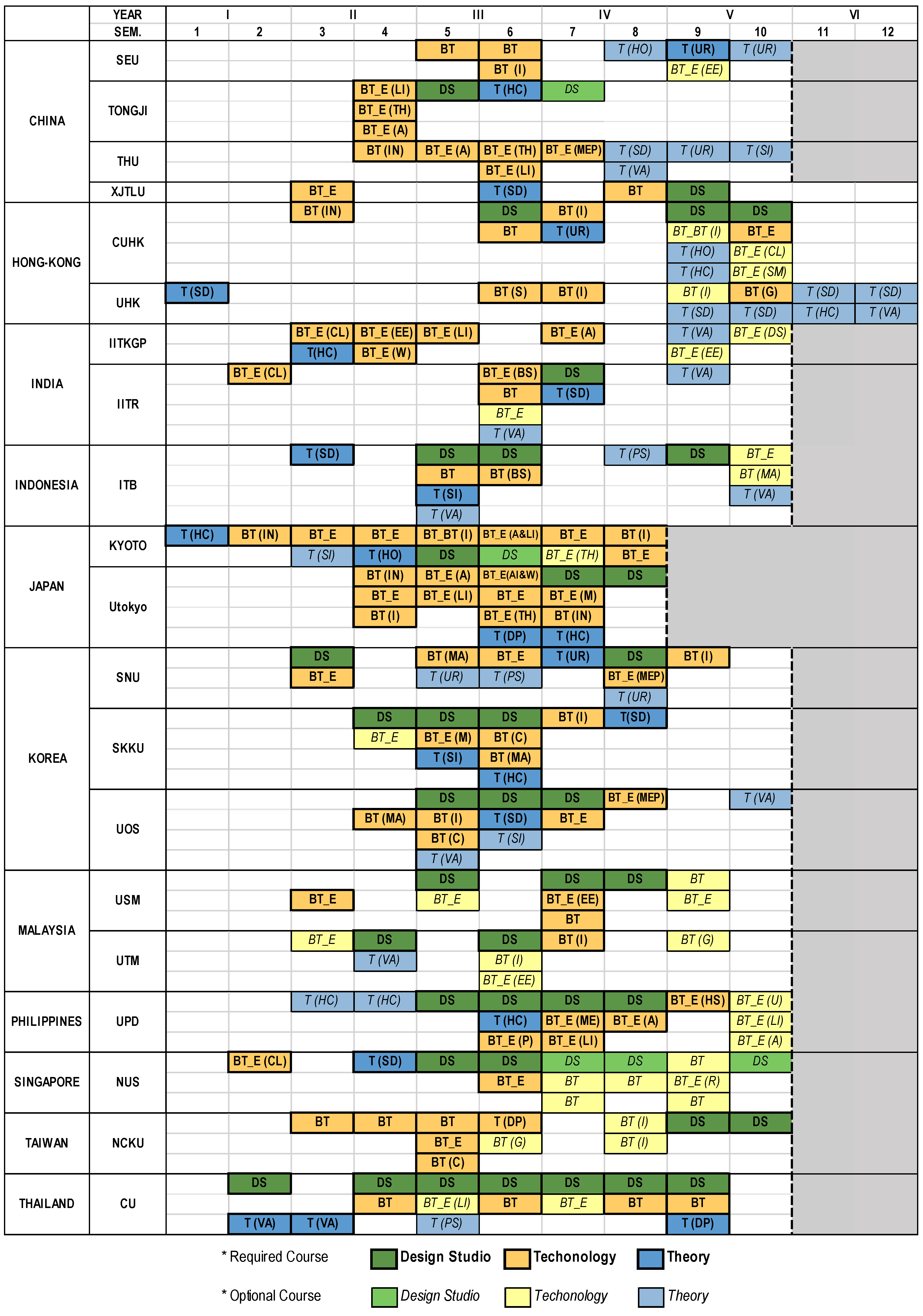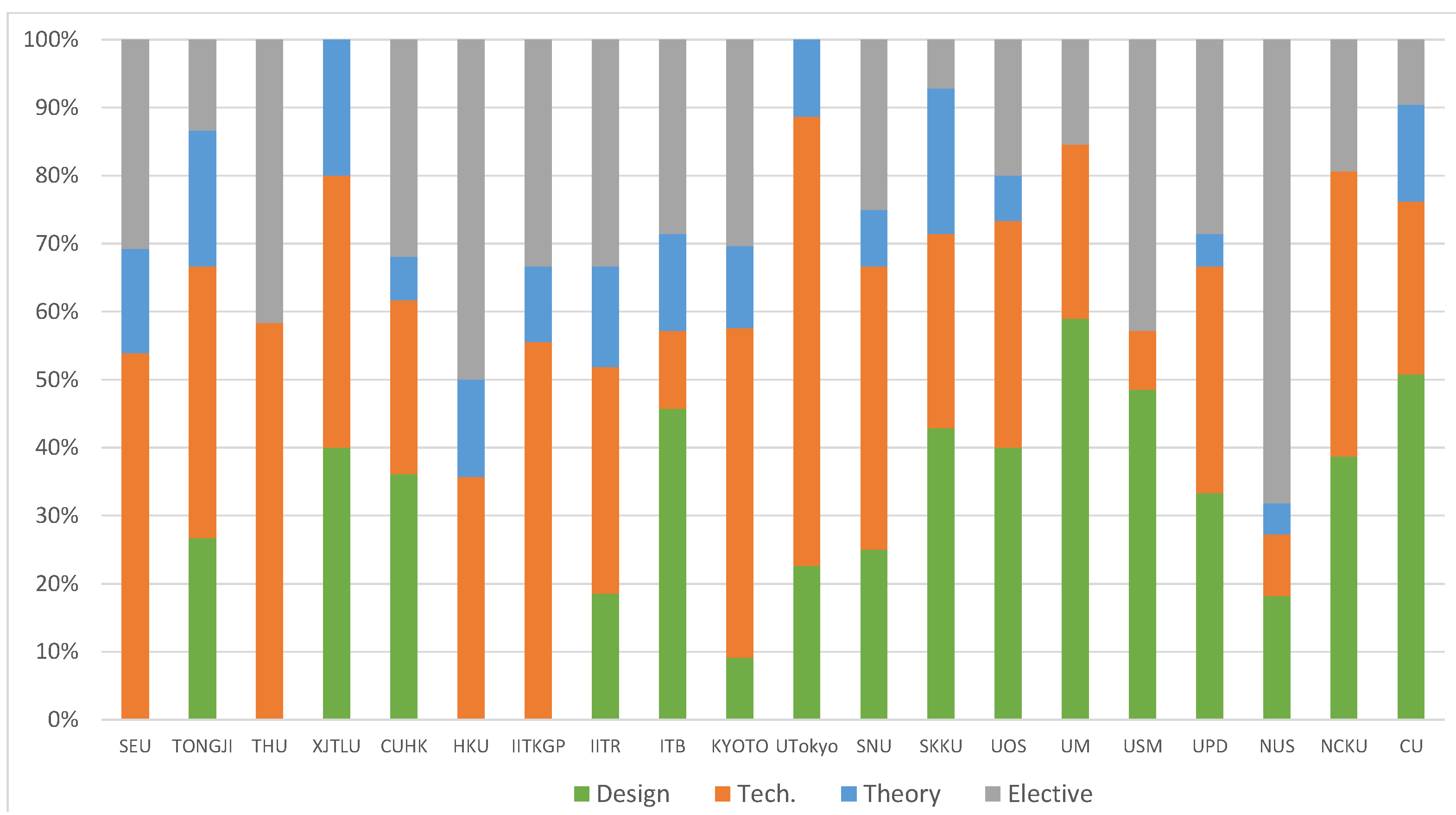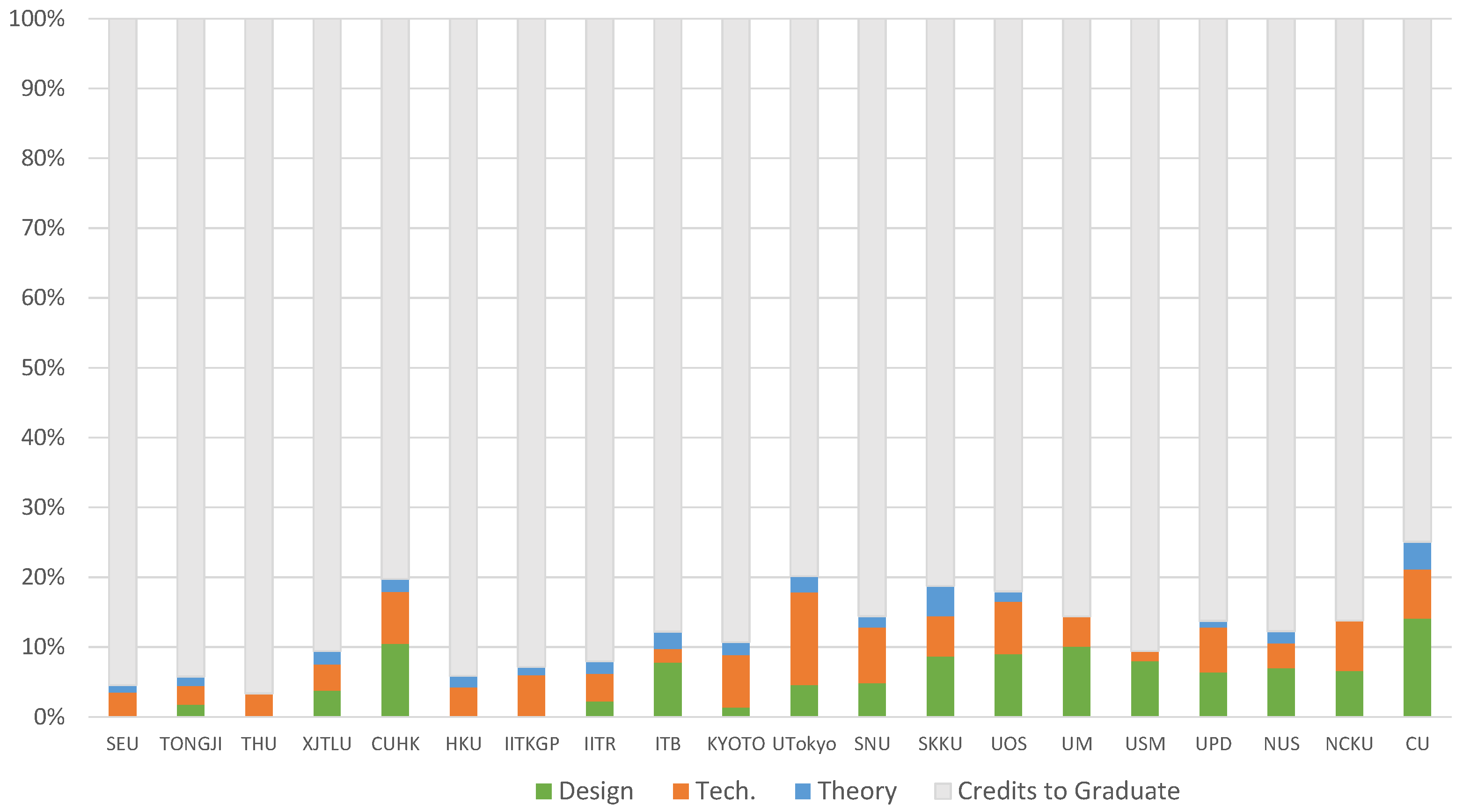A Comparative Study on Sustainability in Architectural Education in Asia—With a Focus on Professional Degree Curricula
Abstract
:1. Introduction
1.1. Motivation
1.2. Literature Review
1.3. Objectives and Paper Outline
2. Methodology
2.1. Delimitation of the Research Subject
2.1.1. Geographical Criteria
2.1.2. Schools Selection Criteria: International/Regional Leadership, National Leadership
2.1.3. Professionally Accredited Curricula
The designation “architect” is generally reserved by law or custom to a person who is professionally and academically qualified and generally registered/licensed/certified to practice architecture in the jurisdiction in which he or she practices and is responsible for advocating the fair and sustainable development, welfare, and the cultural expression of society’s habitat in terms of space, forms, and historical context [30].
2.2. Research Methods
2.2.1. Qualitative Study
- General and conceptual theoretical courses, including cultural, historical and social issues. For a quick overview, in the course matrix we coded them in blue, and for optional courses in light blue with text in italics.
- Technological courses, dealing with energy efficiency, architectural environment understanding, design and control, building systems and systems integration, efficient envelope design, life cycle analysis (LCA), environmental and health issues of construction materials, and any other course strongly related to sustainable technologies. In the course matrix we coded them in dark yellow, and for optional courses in light yellow with text in italics.
- Design studio, architectural design courses with clearly integrated single or multiple sustainable issues. In the course matrix we coded them in dark green, and for optional courses in light green with text in italics.
2.2.2. Quantitative Study
- i.
- Relative weight of sustainability related courses by category: required courses only
- ii.
- Relative weight of sustainability related courses by category: all required and elective courses
- iii.
- Required sustainability credits to total graduation credits ratio
2.2.3. Comparison and Analysis
3. Discussion and Findings
3.1. Curricula Analysis by Countries
3.1.1. China
3.1.2. Hong Kong
3.1.3. India
3.1.4. Indonesia
3.1.5. Japan
3.1.6. Korea
3.1.7. Malaysia
3.1.8. Philippines
3.1.9. Singapore
3.1.10. Taiwan
3.1.11. Thailand
3.2. Comparative Analysis: Qualitative
3.2.1. Course Density Areas
3.2.2. Curricula Length and Intensity
3.2.3. Curricula Courses Sequence Categories
3.2.4. Design Studio as the Real Backbone for Sustainability Education
3.2.5. Balance between Technology, Theory and Design
3.2.6. Global and Local Features
3.3. Comparative Analysis: Quantitative
3.3.1. Course Numbers
3.3.2. Course Credits Relative Weight
4. Conclusions
Supplementary Materials
Acknowledgments
Author Contributions
Conflicts of Interest
Appendix
| Required | Elective | Credits to Graduate | ||||||||||||||||
|---|---|---|---|---|---|---|---|---|---|---|---|---|---|---|---|---|---|---|
| No. of Credits | Weight (100%) | No. of Credits | Weight (100%) | |||||||||||||||
| Design | Tech. | Theory | SUM | Design | Tech. | Theory | SUM | Design | Tech. | Theory | SUM | Design | Tech. | Theory | SUM | |||
| China | SEU | 0.0 | 7.0 | 2.0 | 9.0 | 0.0 | 77.8 | 22.2 | 100.0 | 0.0 | 1.0 | 3.0 | 4.0 | 0.0 | 25.0 | 75.0 | 100.0 | 190 |
| Tongji | 4.0 | 6.0 | 3.0 | 13.0 | 30.8 | 46.2 | 23.1 | 100.0 | 2.0 | 0.0 | 0.0 | 2.0 | 100.0 | 0.0 | 0.0 | 100.0 | 211.5 | |
| THU | 0.0 | 7.0 | 0.0 | 7.0 | 0.0 | 100.0 | 0.0 | 100.0 | 0.0 | 0.0 | 5.0 | 5.0 | 0.0 | 0.0 | 100.0 | 100.0 | 200 | |
| XJTLU | 10.0 | 10.0 | 5.0 | 25.0 | 40.0 | 40.0 | 20.0 | 100.0 | 0.0 | 0.0 | 0.0 | 0.0 | 0.0 | 0.0 | 0.0 | 0.0 | 200 | |
| Hong-Kong | CUHK | 17.0 | 12.0 | 3.0 | 32.0 | 53.1 | 37.5 | 9.4 | 100.0 | 0.0 | 9.0 | 6.0 | 15.0 | 0.0 | 60.0 | 40.0 | 100.0 | 130 |
| HKU | 0.0 | 15.0 | 6.0 | 21.0 | 0.0 | 71.4 | 28.6 | 100.0 | 0.0 | 18.0 | 3.0 | 21.0 | 0.0 | 85.7 | 14.3 | 100.0 | 336 | |
| India | IITKGP | 0.0 | 15.0 | 3.0 | 18.0 | 0.0 | 83.3 | 16.7 | 100.0 | 0.0 | 6.0 | 3.0 | 9.0 | 0.0 | 66.7 | 33.3 | 100.0 | 233 |
| IITR | 5.0 | 9.0 | 4.0 | 18.0 | 27.8 | 50.0 | 22.2 | 100.0 | 0.0 | 3.0 | 6.0 | 9.0 | 0.0 | 33.3 | 66.7 | 100.0 | 208 | |
| Indonesia | ITB | 16.0 | 4.0 | 5.0 | 25.0 | 64.0 | 16.0 | 20.0 | 100.0 | 0.0 | 4.0 | 6.0 | 10.0 | 0.0 | 40.0 | 60.0 | 100.0 | 180 |
| Japan | Kyoto (1) | 2.1 | 11.2 | 2.8 | 16.1 | 13.0 | 69.6 | 17.4 | 100.0 | 3.0 | 2.0 | 2.0 | 7.0 | 42.9 | 28.6 | 28.6 | 100.0 | 134 |
| U-Tokyo (2) | 4.8 | 14.0 | 2.4 | 21.2 | 22.6 | 66.0 | 11.3 | 100.0 | 0.0 | 0.0 | 0.0 | 0.0 | 0.0 | 0.0 | 0.0 | 0.0 | 84 | |
| Korea | SNU | 9.0 | 15.0 | 3.0 | 27.0 | 33.3 | 55.6 | 11.1 | 100.0 | 0.0 | 0.0 | 9.0 | 9.0 | 0.0 | 0.0 | 100.0 | 100.0 | 160 |
| SKKU | 18.0 | 12.0 | 9.0 | 39.0 | 46.2 | 30.8 | 23.1 | 100.0 | 0.0 | 3.0 | 0.0 | 3.0 | 0.0 | 100.0 | 0.0 | 100.0 | 169 | |
| UOS | 18.0 | 15.0 | 3.0 | 36.0 | 50.0 | 41.7 | 8.3 | 100.0 | 0.0 | 0.0 | 9.0 | 9.0 | 0.0 | 0.0 | 100.0 | 100.0 | 164 | |
| Malaysia | UM | 23.0 | 10.0 | 0.0 | 33.0 | 69.7 | 30.3 | 0.0 | 100.0 | 0.0 | 6.0 | 0.0 | 6.0 | 0.0 | 100.0 | 0.0 | 100.0 | 196 |
| USM | 17.0 | 3.0 | 0.0 | 20.0 | 85.0 | 15.0 | 0.0 | 100.0 | 0.0 | 12.0 | 3.0 | 15.0 | 0.0 | 80.0 | 20.0 | 100.0 | 192 | |
| Philippines | UPD | 14.0 | 14.0 | 2.0 | 30.0 | 46.7 | 46.7 | 6.7 | 100.0 | 0.0 | 8.0 | 4.0 | 12.0 | 0.0 | 66.7 | 33.3 | 100.0 | 188 |
| Singapore | NUS | 16.0 | 8.0 | 4.0 | 28.0 | 57.1 | 28.6 | 14.3 | 100.0 | 32.0 | 28.0 | 0.0 | 60.0 | 53.3 | 46.7 | 0.0 | 100.0 | 200 |
| Taiwan | NCKU | 12.0 | 13.0 | 0.0 | 25.0 | 48.0 | 52.0 | 0.0 | 100.0 | 0.0 | 6.0 | 0.0 | 6.0 | 0.0 | 100.0 | 0.0 | 100.0 | 156 |
| Thailand | CU | 32.0 | 16.0 | 9.0 | 57.0 | 56.1 | 28.1 | 15.8 | 100.0 | 0.0 | 4.0 | 2.0 | 6.0 | 0.0 | 66.7 | 33.3 | 100.0 | 170 |
| Average | 37.3 | 50.3 | 12.4 | 100.0 | 10.9 | 50.0 | 39.1 | 100.0 | ||||||||||
References
- East-West Center. The Future of Population in Asia. In Population and Health Studies; East-West Center Research Program: Honolulu, HI, USA, 2002. [Google Scholar]
- UN. Population Trends in Asia and the Pacific, United Nations Report. 2002. Available online: http://www.eastwestcenter.org/publications/future-population-asia (accessed on 19 February 2016).
- Fien, J.; Tilbury, D. The global challenge of Sustainability. In Education and Sustainable Development. Responding to the Global Challenge; Tilbury, D., Stevenson, R.B., Fien, J., Schereuder, D., Eds.; IUCN Commission on Education and Communication: Cambridge, UK, 2002; pp. 1–12. [Google Scholar]
- UN Habitat, The State of Asian and Pacific Cities 2015: Urban transformations Shifting from quantity to quality. UN Habitat, London, UK. 2015. Available online: http://unhabitat.org/books/the-state-of-asian-and-pacific-cities-2015/ (accessed on 18 March 2016).
- Brundtland, G.; Khalid, M.; Agnelli, S.; Al-Athel, S.; Chidzero, B.; Fadika, L.; Hauff, V.; Lang, I.; Shijun, M.; de Botero, M.M. Our Common Future (Brundtland Report); World Comission on Environment and Development, United Nations, 1987; Avaliable online: http://www.un-documents.net/our-common-future.pdf (accessed on 17 March 2016).
- Rio Declaration on Environment and Development. United Nations Conference on Environment and Development, Rio de Janeiro, Brazil, 3–14 June 1992. Available online: http://www.unep.org/documents.multilingual/default.asp?documentid=78&articleid=1163 (accessed on 17 March 2016).
- United Nations, Agenda 21. Available online: https://sustainabledevelopment.un.org/outcomedocuments/agenda21 (accessed on 3 February 2016).
- UNFCCC. United Nations Framework Convention on Climate Change. COP 15. Copenhagen 2009. Available online: http://unfccc.int/meetings/copenhagen_dec_2009/session/6262/php/view/reports.php (accessed on 3 February 2016).
- Hopkins, C.; McKeown, R. Education for Sustainable Development: An International Perspective. In Education and Sustainable Development. Responding to the Global Challenge; Tilbury, D., Stevenson, R.B., Fien, J., Schereuder, D., Eds.; IUCN Commission on Education and Communication: Cambridge, UK, 2002; pp. 13–26. [Google Scholar]
- Malik, A.; Rahman, A. Greening the Architectural Curriculum in All the Malaysian Institutes of Higher Learning-it is not an Option. Int. J. Archit. Res. 2010, 4, 44–53. [Google Scholar]
- Kishnani, N. Greening Asia: Emerging Principles for Sustainable Architecture; BCI Asia: Singapore, 2012. [Google Scholar]
- Salama, A. Skill-based/Knowledge-based Architectural Pedagogies: An Argument for Creating Humane Environments. In Proceedings of the 7th International Conference of the IAHH-International Association of Humane Habitat-Enlightening Learning Environments, International Association of Humane Habitat–IAHH, Compact Disc, Mumbai, India, 29–31 January 2005.
- Wright, J. Introducing Sustainability into the Architecture Curriculum in the United States. Int. J. Sustain. High. Educ. 2003, 4, 100–105. [Google Scholar] [CrossRef]
- Altomonte, S. Environmental Education for Sustainable Architecture. Rev. Eur. Stud. 2009, 1, 12–21. [Google Scholar] [CrossRef]
- Salama, A.; Amir, A. Paradigmatic Trends in Arab Architectural Education: Impacts and Challenges. In International Union of Architects-UIA XXII World Congress, Istanbul, Turkey, 3–7 July 2005; Available online: http://citeseerx.ist.psu.edu/viewdoc/download?doi=10.1.1.122.8202&rep=rep1&type=pdf (accessed on 16 March 2016).
- Ostwald, M.J.; Williams, A.; Learning, A.; Council, T. Understanding Architectural Education in Australasia; Australian Learning and Teaching Council: Sydney, Australia, 2008. [Google Scholar]
- Altomonte, S.; Attia, S.; Herde, A.; Dartevelle, O. EDUCATE State of the Art Academic Curricula and Conditions for Registration; Nottingham University: Nottingham, UK, 2010. [Google Scholar]
- Lee, K.Y.D.; Geon, K. A Study on Integrating Sustainability into Architectural Education Curriculum in Korea. J. Archit. Inst. Korea 2012, 28, 127–138. [Google Scholar]
- The Homepage of the Australasia Association of Schools of Architecture (AASA). Available online: http://aasa.org.au/schools/ (accessed on 2 February 2016).
- Karol, E. Using campus concerns about sustainability as an educational opportunity: A case study in architectural design. J. Clean. Prod. 2006, 14, 780–786. [Google Scholar] [CrossRef]
- Knudstrup, M.A.; Eriksen, K.; Petersen, M.D. Education in Sustainable Architecture for the Future—For a Joint Climate Action. In Proceedings of Joint Action on Climate Change Conference, Institut for Samfundsudvikling og Planlægning, Aalborg Universitet, Aalborg, Denmark, 8–10 June 2009; pp. 333–335.
- Tanuwidjaja, G.; Leonardo, L. Sustainable Architectural Design in Indonesia: Responding the Current Environmental Challenges. J. Ruas 2012, 9, 28–36. [Google Scholar]
- Hamiti, S.; Wydler, H. Supporting the Integration of Sustainability into Higher Education Curricula—A Case Study from Switzerland. Sustainability 2014, 6, 3291–3300. [Google Scholar] [CrossRef]
- Knight, J.; Morshidi, S. The complexities and challenges of regional education hubs: Focus on Malaysia. High. Educ. 2011, 62, 593–606. [Google Scholar] [CrossRef]
- QS Top Universities, Worldwide University Rankings, Guides and Events. Available online: http://www.topuniversities.com/university-rankings (accessed on 14 February 2016).
- Rauhvargers, A. Global University Rankings and Their Impact—Report II; European University Association asbl: Brussels, Belgium, 2013; p. 86. [Google Scholar]
- QS World University Rankings: Methodology. Available online: http://www.topuniversities.com/university-rankings-articles/world-university-rankings/qs-world-university-rankings-methodology (accessed on 5 February 2016).
- QS World University Rankings by Subject 2015—Architecture/Built Environment—Asia. Available online: http://www.topuniversities.com/university-rankings/university-subject-rankings/2015/architecture#sorting=rank+region=71+country=+faculty=+stars=false+search= (accessed on 13 February 2016).
- QS University Rankings: Asia 2015. Available online: http://www.topuniversities.com/university-rankings/asian-university-rankings/2015#sorting=rank+region=+country=+faculty=+stars=false+search= (accessed on 5 February 2016).
- UIA. UIA Accord on Recommended International Standards of Professionalism in Architectural Practice; UIA Professional Practice Program Joint Secretariat: Durban, South Africa, 2014. [Google Scholar]
- NBAA. Universities That Have Passed the Architectural Accreditation, National Board of Architectural Accreditation of China (NBAA). Available online: http://www.canberraaccord.org/signatoriespublic/China.aspx (accessed on 5 February 2016).
- The Homepage of Hong Kong Architects Registration Board (ARB). Available online: http://www.arb.org.hk (accessed on 4 February 2016).
- The Homepage of Hong-Kong Institute of Architects (HKIA). Available online: http://www.hkia.net/en/Home/Index.htm (accessed on 4 February 2016).
- The Homepage of Council of Architecture (COA), India. Available online: http://www.coa.gov.in/ (accessed on 10 February 2016).
- The Homepage of Indonesian Institute of Architects (Ikatan Arksitek Indonesia, IAI). Available online: http://www.iai.or.id (accessed on 13 February 2016).
- JABEE Category-Dependent Criteria for Accreditation of Professional Education Programs, 2012. Available online: http://www.jabee.org/english (accessed on 4 February 2016).
- The Homepage of JUAA, Japan University Accreditation Association. Available online: http://juaa.or.jp/en/index.html (accessed on 4 February 2016).
- Korea Architectural Accrediting Board, KAAB. Conditions & Procedures for Professional Degree Programs in Architecture, 2013 Edition. Available online: http://www.kaab.or.kr/download/KAAB_2013_C_and_P.pdf (accessed on 11 February 2016).
- Official Portal Public Service Department of Malaysia (JPA). Available online: http://www.jpa.gov.my (accessed on 13 February 2016).
- The Homepage of Board of Architects Malaysia (Lembega Arkitekt Malaysia, LAM). Available online: http://www.lam.gov.my (accessed on 13 February 2016).
- The Homepage of Malayan Institute of Architects (Pertubuhan Akitekt Malaysia, PAM). Available online: http://www.pam.org.my (accessed on 13 February 2016).
- CHED. Memorandum Order (CMO) No. 61: Series of 2006. Policies, Standards and Guidelines (PSG) for the Bachelor of Science in Architecture. Commission on Higher Education, Republic of the Philippines. Available online: http://www.architectureboard.ph/uploads/1253926997-BS%20Architecture%20curriculum.pdf (accessed on 4 February 2016).
- Institute of Engineering Education Taiwan, Accreditation Council: Architectural Accreditation Criteria. 27 November 2015. Available online: http://www.ieet.org.tw/InfoTE.aspx?n=AACE (accessed on 4 February 2016).
- The Homepage of the Royal Institute of British Architects (RIBA). Available online: https://www.architecture.com/RIBA/Home.aspx (accessed on 13 February 2016).
- The Homepage of the Royal Institution of Chartered Surveyors (RICS). Available online: http://www.rics.org/es/ (accessed on 13 February 2016).
- The Homepage of the Commonwealth Association of Architects (CAA). Available online: http://www.comarchitect.org (accessed on 13 February 2016).
- Gibson, R.B. Beyond the pillars: Sustainability assessment as a framework for effective integration of social, economic and ecological considerations in significant decision-making. J. Environ. Assess. Policy Manag. 2006, 8, 259–280. [Google Scholar] [CrossRef]
- The Pritzker Prize Homepage. Available online: http://www.pritzkerprize.com (accessed on 14 February 2016).
- The Homepage of the School of Architecture in Southeast University. Available online: http://arch.seu.edu.cn/home/index.php (accessed on 5 February 2016).
- Ranking of Architecture Schools in China, China Academic Degrees & Graduate Education Development Center, Ministry of Education. Available online: http://edu.sina.com.cn/kaoyan/2013-01-29/1127370395.shtml (accessed on 16 February 2016).
- The Homepage of Tsinghua University. Available online: http://www.tsinghua.edu.cn/publish/archen/education/ (accessed on 3 May 2015).
- The Homepage of Tongji University Department of Architecture. Available online: http://www.tongji-arch.org/en_introdution.asp (accessed on 3 February 2016).
- Architectural Curriculum of Xi’an Jiaotong Liverpool University. Available online: http://academic.xjtlu.edu.cn/arch/programmes?menuCode=001 (accessed on 3 February 2016).
- SEU School of Architecture Curriculum in English. Available online: http://school.cucas.edu.cn/uploads/school/2014/0308/1394257259100915.pdf (accessed on 5 February 2016).
- The Homepage of the Department of Architecture, Xi’an Jiaotong Liverpool University. Available online: http://academic.xjtlu.edu.cn/arch/SitePages/HomePage.aspx (accessed on 3 February 2016).
- Xi’an Jiaotong Liverpool University Department of Architecture 2013–2014. Available online: http://academic.xjtlu.edu.cn/arch/SitePages/HomePage.aspx (accessed on 3 February 2016).
- Xi’an Jiaotong Liverpool University Department of Architecture Master curriculum. Available online: http://www.xjtlu.edu.cn/en/admissions/masters/programmes/952-master-of-architectural-design.html (accessed on 3 February 2016).
- Tongji University Department of Architecture Curriculum and Syllabus. Available online: http://www.tongji-arch.org/specials_list1.asp (accessed on 3 February 2016).
- Tongji University Architecture Curriculum. Available online: http://www.doc88.com/p-1896812328481.html (accessed on 14 February 2016).
- Architecture Curriculum of South East University. Available online: http://www.doc88.com/p-0032954674714.html (accessed on 14 February 2016).
- Tsinghua University School of Architecture Syllabus for 2013–2014. Available online: http://www.tsinghua.edu.cn/publish/newthu/newthu_cnt/education/pdf/201402.pdf (accessed on 3 May 2015).
- Tsinghua University Architecture Undergraduate Program. Available online: http://www.doc88.com/p-9522398094279.html (accessed on 14 February 2016).
- HKU. 2013/14 Prospectus, HKU Department of Architecture 2012/ 13 Review; The Department of Architecture, The University of Hong Kong: Hong Kong, China, 2014; p. 144. [Google Scholar]
- The Homepage of the School of Architecture, Chinese University of Hong Kong (CUHK). Available online: http://www.arch.cuhk.edu.hk (accessed on 3 May 2015).
- Lonman, B. School of Architecture. CUHK. 2014–2015. Available online: http://www.arch.cuhk.edu.hk/v1/index.php/resources/page/publication (accessed on 3 May 2015).
- The Homepage of Faculty of Architecture, The University of Hong Kong. Available online: http://www.arch.hku.hk (accessed on 10 December 2015).
- The Homepage of New Undergraduate Curriculum from 2012. Available online: http://www.cuhk.edu.hk/334/english/index-students.html (accessed on 3 May 2015).
- The Homepage of the Department of Architecture and Planning, Indian Institute of Technology Roorkee. Available online: http://www.iitr.ac.in/departments/AR/pages/About_Us+History.html (accessed on 14 February 2016).
- The Homepage of Indian Institute of Technology Kharagpur, India. Available online: http://www.iitkgp.ac.in/ (accessed on 10 February 2016).
- The Homepage of Undergraduate Curriculum. Available online: https://erp.iitkgp.ernet.in/ERPWebServices/curricula/CurriculaSubjectsList.jsp?stuType=UG&splCode=AR (accessed on 10 February 2016).
- Department of Architecture and Planning Curriculum. Available online: http://www.iitr.ac.in/academics/uploads/File/2015/syllabi/UG/AR%20PDF.pdf (accessed on 14 February 2016).
- ITB. Institut Teknologi Bandung Undergraduate Student Handbook 2010. Available online: http://www.itb.ac.id/education/ITB_undergraduate_handbook.pdf (accessed on 1 February 2016).
- Architecture Master Program, Architecture ITB. Available online: http://www.ar.itb.ac.id/master/ (accessed on 13 February 2016).
- Prospectus 2014, School Of Architecture, Planning & Policy Development, 2014. Available online: http://sappk.itb.ac.id/upload/FINAL%20CETAK%20-%20SAPPK%20Prospektus%20-%20BUKU%20Single%20Page-1.pdf (accessed on 19 February 2016).
- The Homepage of the Department of Architecture, University of Tokyo. Available online: http://arch.t.u-tokyo.ac.jp/?lang=en (accessed on 10 February 2016).
- The Homepage of the Department of Architecture Kyoto University. Available online: http://www.s-ar.t.kyoto-u.ac.jp/en (accessed on 6 February 2016).
- Department of Architecture Lecture Timetable for Undergraduate. Available online: http://arch.t.u-tokyo.ac.jp/about/activity-1097/ (accessed on 19 February 2016).
- Architecture Syllabus Kyoto University. Available online: http://www.s-ar.t.kyoto-u.ac.jp/ja/curriculum/syllabus (accessed on 3 February 2016).
- The Japan Institute of Architects (JIA), Country Report: Kechikusi Law in Japan. Available online: http://www.jia.or.jp/english/ (accessed on 5 February 2016).
- Kyoto University Department of Architecture, JABEE Accreditation Documents. Available online: http://www.s-ar.t.kyoto-u.ac.jp/ja/admission/JABEE (accessed on 12 February 2016).
- Credit Requirements for Graduation, College of Engineering, The University of Tokyo. Available online: http://www.u-tokyo.ac.jp/gen01/reiki_int/reiki_honbun/word/403250021.doc (accessed on 14 February 2016).
- Architecture Undergraduate Curricula, Kyoto University. Available online: http://www.s-ar.t.kyoto-u.ac.jp/ja/curriculum/youran (accessed on 6 February 2016).
- Message from the Dean of the Department of Architecture. Available online: http://arch.t.u-tokyo.ac.jp/about/message-from-head-of-dept-of-architecture/ (accessed on 19 February 2016).
- Okada, T. Reform of Holistic Architectural Education in Japan. Architectural Institute of Japan. 2000. Available online: http://www.aij.or.jp/eng/archives/98_00doc/uiappc_c.html (accessed on 16 March 2016).
- The Homepage of Seoul National University Department of Architecture. Available online: http://architecture.snu.ac.kr/English/ (accessed on 19 February 2016).
- The Homepage of Sungkyunkwan University Department of Architecture. Available online: http://arch.skku.edu/page/view.php?idx=2 (accessed on 10 February 2016).
- The Homepage of UOS Architecture. Available online: http://arch.uos.ac.kr/hakbu_eng/architecture/ (accessed on 3 May 2015).
- UOS Architecture: School Introduction. Available online: http://archi.uos.ac.kr/school/about/ (accessed on 11 February 2016).
- SNU Department of Architecture Curriculum. Available online: http://architecture.snu.ac.kr/academics/curriculum_2016.php (accessed on 17 March 2016).
- SNU Portal of Course Registration System. Available online: http://sugang.snu.ac.kr (accessed on 10 February 2016).
- SKKU Department of Architecture Curriculum. Available online: http://www.skku.edu/eng_home/edu/hu_science/curriculum_info.jsp?gCode=316307&pageId=655&imgTitleId=p000081 (accessed on 10 February 2016).
- Department of Architecture, Sungkyunkwan University. Architecture Program Report (APR); Department of Architecture, Sungkyunkwan University: Suwon, Korea, 2012. [Google Scholar]
- Rieh, S.-Y. Teaching Sustainable Architecture: Holistic Approach for a Sustainable Design Studio. In Proceedings of the International Symposium on Architectural Interchanges in Asia (ISAIA), Gwang-Ju, Korea, 22–25 October 2012.
- The Homepage of the School of Housing, Building and Planning, Universiti Sains Malaysia. Available online: http://hbp.usm.my/index.php/ms/ (accessed on 14 February 2016).
- Universiti Sains Malaysia, Bachelor of Architecture, Academic Session 2014/2015. Available online: https://www.usm.my/images/pdf_ijazah/1314hbp.pdf (accessed on 14 February 2016).
- Faculty of Built Environment, Academic Guidebook Academic Year 2013/2014. Universiti Teknologi Malaysia. Available online: http://fab.utm.my/wp-content/uploads/2015/08/FabGuideBook2013–2014_FINAL.pdf (accessed on 14 February 2016).
- The Homepage of Universiti Teknologi Malaysia Department of Architecture. Available online: http://fab.utm.my/departments-institutes/architecture/ (accessed on 14 February 2016).
- UTM. Academic Guidebook Academic Year 2013/2014; Faculty of Built Environment, Univeristi Teknologi Malaysia: Johor, Malaysia, 2013. [Google Scholar]
- The Homepage of the College of Architecture, University of the Philippines Diliman. Available online: http://upca.upd.edu.ph (accessed on 4 February 2016).
- UPD MsArch Curriculum. Available online: http://upca.upd.edu.ph/uploads/1/8/5/4/18549486/bs_architecture_2012.pdf (accessed on 1 February 2016).
- UPD MsArch Course Description. Available online: http://upca.upd.edu.ph/uploads/1/8/5/4/18549486/bs_arch_2012_course_desc.pdf (accessed on 1 February 2016).
- The Homepage of the Department of Architecture, National University of Singapore (NUS). Available online: http://www.arch.nus.edu.sg/about-us/about-us.html (accessed on 11 February 2016).
- NUS Architecture BA Course Information. Available online: http://www.comp.nus.edu.sg/~junzhi/registrar/SDE/UG/UGedu.html (accessed on 3 May 2015).
- NUS Centralized Online Undergraduates Registration System (CORS). Available online: http://www.cors.nus.edu.sg/ (accessed on 16 February 2016).
- NUS Learning Management System. Available online: https://ivle.nus.edu.sg/V1/lms/public/view_moduleoutline.aspx?CourseID=B18E5999–3C47–41FC-9DFF-CA91F634983F&ClickFrom=StuViewBtn (accessed on 16 February 2016).
- NUS Course Information. Available online: https://ivle.nus.edu.sg/lms/public/list_course_public.aspx? (accessed on 3 May 2015).
- NUS Architecture MArch Course Information. Available online: https://www.arch.nus.edu.sg/programme/architecture/m-arch/master_dtm_info.html (accessed on 26 February 2016).
- AD Architecture School Guide: National University of Singapore. Available online: http://www.archdaily.com/462070/ad-architecture-school-guide-national-university-of-singapore/ (accessed on 3 May 2015).
- Marginson, S.; van der Wende, M. Globalization and Higher Education; OECD Education Working Papers, No. 8; OECD Publishing (NJ1): Paris, France, 2007. [Google Scholar]
- The Homepage of National Cheng Kung University (NCKU) Department of Architecture. Available online: http://www.arch.ncku.edu.tw/en (accessed on 3 February 2016).
- Department of Architecture National Cheng Kung University Curricula. Available online: http://www.arch.ncku.edu.tw/content/課程 (accessed on 18 March 2016).
- National Cheng Kung University Course Catalog. Available online: http://class-qry.acad.ncku.edu.tw/qry/index.php (accessed on 12 February 2016).
- The Homepage of the Department of Architecture, Chulalongkorn University. Available online: http://www.archdept.com/web/index.php (accessed on 4 February 2016).
- Information: Department of Architecture Chulalongkorn University. Available online: http://www.archdept.com/web/information.php (accessed on 19 February 2016).
- Department of Architecture 2014 Yearbook, Chulalongkorn University. Available online: http://www.archdept.com/web/showcase_detail19.php (accessed on 4 February 2016).
- Kishnani, N.; Ng, L.J. Educating the architect; formation of sustainability constructs. In Proceedings of the Sustainable Buildings Conference, Helsinki, Finland, 18–21 October 2011.




| Country | University | Initial | Degree | Years | Asia Rank 1 | Nat. Rank 2 | Nat. Accr. | Intl. Accr. |
|---|---|---|---|---|---|---|---|---|
| China | Southeast Univ. | SEU | BArch | 5 | N | Y | NBAA | |
| Tongi Univ. | Tongji | BArch | 5 | Y | Y | NBAA | ||
| Tsinghua Univ. | THU | BArch | 5 | Y | Y | NBAA | ||
| Xian Jiaotong Liverpool Univ. | XJTLU | BEng + MArch | 4 + 2 | N | Y 3 | NBAA 4 | RIBA I, (II) 4 | |
| Hong Kong | Chinese Univ. of Hong-Kong | CUHK | BSSc (AS) + MArch | 4 + 2 | Y | Y | HKIA, ARB | RIBA |
| Univ. of Hong-Kong | HKU | BA (AS) + MArch | 4 + 2 | Y | Y | HKIA, ARB, NBAA | RIBA CAA | |
| India | India Inst. of Tech. Kharagpur | IITKGP | BArch | 5 | N | Y | COA | |
| India Inst. of Tech. Roorkee | IITR | BArch | 5 | N | Y | COA | ||
| Indonesia | Institute of Technology Bandung | ITB | BA (Arch) + MArch | 4 + 1 5 | N | Y | IAI | KAAB 6 |
| Japan | Kyoto University | Kyoto | BArch | 4 | Y | Y | JABEE 7 | |
| The University of Tokyo | UTokyo | BArch | 4 | Y | Y | JUAA 8 | ||
| Korea | Seoul National Univ. | SNU | BArch | 5 | Y | Y | KAAB | |
| Sungkyunkwan Univ. | SKKU | BArch | 5 | Y | Y | KAAB | ||
| University of Seoul | UOS | BArch | 5 | N | Y | KAAB | ||
| Malaysia | Universiti Sans Malaysia | USM | BsArch + BArch | 3 + 2 | Y | Y | LAM I, II | RICS |
| Universiti Teknologi Malaysia | UTM | BScArch + MArch | 3 + 2 | N | Y | LAM I, II, PAM, JPA | ||
| Philippines | University of the Philippines Diliman | UPD | MsArch | 5 | N | Y | CHED | |
| Singapore | Nat. Univ. of Singapore | NUS | BA (Arch) + MArch | 4 + 1 | Y | Y | RIBA I, II | |
| Taiwan | Nat. Cheng Kung Univ. | NCKU | BArch | 5 | Y | Y | HEEACT | |
| Thailand | Chulalongkorn Univ. | CU | BArch | 5 | Y | Y | ACT |
| Abbreviation | Full Name |
|---|---|
| ACT | Architect Council of Thailand |
| ARB | Architects Registration Board of Hong Kong |
| CAA | Commonwealth Association of Architects |
| CHED | Commission of Higher Education (Philippines) |
| COA | Council of Architecture (India) |
| HEEACT | Higher Education Evaluation and Accreditation Council of Taiwan |
| HKIA | Hong Kong Institute of Architects |
| IAI | Indonesian Institute of Architects |
| JABEE | Japan Accreditation Board for Eng. Education |
| JPA | Public Service Department (Malaysia) |
| JUAA | Japan University Accreditation Association |
| KAAB | Korean Architectural Accreditation Board |
| LAM (or BAM) | Board of Architects Malaysia |
| NBAA | National Board of Architectural Accreditation (China) |
| PAM | Malaysian Institute of Architect |
| RIBA | Royal British Institute of Architects (UK) |
| RICS | Royal Institution of Chartered Surveyors (UK) |
| Abbreviation | Full Name |
|---|---|
| BArch | Bachelor of Architecture |
| BA (Arch) | Bachelor of Arts in Architecture |
| BA (AS) | Bachelor of Arts in Architectural Studies |
| BEng | Bachelor of Engineering |
| BsArch | Bachelor of Science in Architecture |
| BSc | Bachelor of Science |
| BSSc (AS) | Bachelor of Social Sciences in Architectural Studies |
| MArch | Master of Architecture |
| MsARCH | Master of Science in Architecture |
| Abbreviation | Full Name | Abbreviation | Full Name |
|---|---|---|---|
| DS | Design Studio | BT_E (HS) | Health & Safety in Building |
| BT | Building Technology, Building Physics | BT_E (LI) | Lighting |
| BT (C) | Construction | BT_E (M) | Mechanical |
| BT (G) | Green Building | BT_E (MEP) | Mechanical, Electrical, Plumbing |
| BT (I) | Integration, Building System, Façade | BT_E (P) | Plumbing |
| BT (IN) | Introduction | BT_E (PO) | Pollution |
| BT (MA) | Material | BT_E (R) | Renewable Energy |
| BT _E (U) | Utilities for Building Interiors | BT_E (SM) | Simulation |
| BT_E | Environmental (Engg. Tech.) | BT_E (TH) | Thermal |
| BT_E (A & LI) | Acoustic & Lighting | BT_E (W) | Water |
| BT_E (A) | Acoustic | T (DP) | Design Planning, Programming |
| BT_E (AI & W) | Air & Water | T (HC) | History, Culture, Theory |
| BT_E (BS) | Building Services | T (HO) | Housing |
| BT_E (CL) | Climate | T (PS) | Conservation, Preservation |
| BT_E (DS) | Disaster Resistant | T (SD) | Sustainable (Design, Architecture) |
| BT_E (EE) | Energy Efficient | T (SI) | Site (Landscape) |
© 2016 by the authors; licensee MDPI, Basel, Switzerland. This article is an open access article distributed under the terms and conditions of the Creative Commons by Attribution (CC-BY) license (http://creativecommons.org/licenses/by/4.0/).
Share and Cite
Porras Álvarez, S.; Lee, K.; Park, J.; Rieh, S.-Y. A Comparative Study on Sustainability in Architectural Education in Asia—With a Focus on Professional Degree Curricula. Sustainability 2016, 8, 290. https://doi.org/10.3390/su8030290
Porras Álvarez S, Lee K, Park J, Rieh S-Y. A Comparative Study on Sustainability in Architectural Education in Asia—With a Focus on Professional Degree Curricula. Sustainability. 2016; 8(3):290. https://doi.org/10.3390/su8030290
Chicago/Turabian StylePorras Álvarez, Santiago, Kyungsun Lee, Jiyoung Park, and Sun-Young Rieh. 2016. "A Comparative Study on Sustainability in Architectural Education in Asia—With a Focus on Professional Degree Curricula" Sustainability 8, no. 3: 290. https://doi.org/10.3390/su8030290







